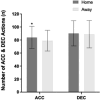Playing position and match location affect the number of high-intensity efforts more than the quality of the opposition in elite football players
- PMID: 38952904
- PMCID: PMC11167469
- DOI: 10.5114/biolsport.2024.133669
Playing position and match location affect the number of high-intensity efforts more than the quality of the opposition in elite football players
Abstract
This study aimed to examine the impact of playing position (PP), match location (ML), and opposition standard (OS) on team and individual acceleration (ACC) and deceleration (DEC) efforts. Fifty professional football players were monitored across 24 English Premier Development League matches during the 2020/21 season. High-intensity ACC and DEC thresholds were set at > +3 m · s-2 and < -3 m · s-2, respectively. Players were divided into five PPs: centre backs (CB; n = 68), full-backs (FB; n = 24), centre midfielders (CM; n = 54), wide midfielders (WM; n = 15), centre forwards (CF; n = 27). Opposition standard was categorised as Top (1st-4th), Middle (5th-9th), and Bottom (9th-13th) based on final league ranking of the study season. Each match location was classified as Home or Away. One way analysis of variance (ANOVA) and a multivariate ANOVA analysed the independent effect of PP, ML and OS on ACC and DEC efforts, and the interaction of all contextual factors, respectively. Acceleration efforts were affected by PP and ML. FB performed 22% more ACC than WM. All players performed 6% more ACC actions during home matches compared to away fixtures. DEC efforts were only affected by PP, with FB and CM executing 26% and 32% greater DEC efforts than CB, respectively. When playing against top or middle teams at home, CB, CM, and CF tended to perform more high-intensity actions than when playing away. In contrast, when playing against top teams at home, FB and WM performed fewer high-intensity actions than when playing away. Playing position and ML affected ACC and DEC actions but not OS.
Keywords: Accelerometry-based variables; Developing players; High-intensity actions; Position-specific demands; Soccer.
Copyright © Institute of Sport – National Research Instutite.
Conflict of interest statement
The authors declare no conflict of interest.
Figures




References
-
- Dalen T, Jørgen I, Gertjan E, Havard HG, Ulrik W. Player load, acceleration, and deceleration during forty-five competitive matches of elite soccer. J Strength Cond Res. 2016; 30(2):351–9. - PubMed
-
- Varley MC, Aughey RJ. Acceleration profiles in elite Australian soccer. Int J Sports Med. 2013; 34(01):34–9. - PubMed
-
- Rampinini E, Coutts AJ, Castagna C, Sassi R, Impellizzeri F. Variation in top level soccer match performance. International J Sports Med. 2007; 28(12):1018–24. - PubMed
-
- Delaney JA, Cummins CJ, Thornton HR, Duthie GM. Importance, reliability, and usefulness of acceleration measures in team sports. J Strength Cond Res. 2018; 32(12):3485–93. - PubMed
LinkOut - more resources
Full Text Sources
Research Materials
Miscellaneous
